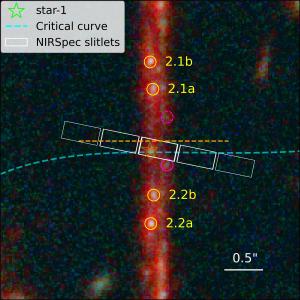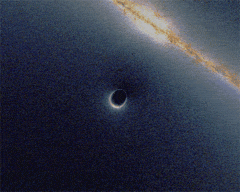Blog
Reaching for the Star
7 August 2023
 JWST/Furtak, et al
JWST/Furtak, et alThe stars we see in the night sky are close neighbors. Even in the darkest sky, the individual points of light we see are all within a few thousand light-years from Earth. We can see more distant objects such as globular clusters tens of thousands of light-years away, and faint nearby galaxies such as Andromeda are more than a million light-years distant. But we don’t see those as individual stars. Modern telescopes can see individual stars in the Andromeda galaxy and other nearby galaxies. But even they find it difficult to see individual stars in a galaxy billions of light years away. But a chance alignment and a trick of gravity have allowed astronomers to see light from a single star nearly 12.5 billion light-years away.1
 Wikipedia user Urbane Legend
Wikipedia user Urbane LegendThe trick is known as gravitational lensing. When light passes near a large mass such as a star, black hole, or galaxy, its path is deflected slightly. It’s a lens effect because light passing on either side of the mass can be focused in much the same way that a glass lens focuses light. If the mass and light source are aligned just so, gravitational lensing can make the distant object appear larger and brighter, as you can see in the simulated image to the right.
Thanks to this magnifying effect, astronomers can see objects that are far too distant or faint to be visible otherwise. That’s what has happened in this particular case. A distant star is aligned perfectly with a closer galaxy cluster, making it bright enough to stand out among other stars in images captured by the James Webb Space Telescope (JWST).
What’s amazing is that they not only captured an image of the star, they also gathered spectroscopic data. From this, the team was able to determine the star is a B-type blue giant star. It might also have a companion a bit smaller than the Sun. It has a redshift of about z = 4.57, meaning the starlight began its journey when the universe was little more than a billion years old.
JWST is particularly good at seeing these kinds of lensed stars, so in the near future, we are likely to have more observations of individual stars from the distant universe. That means we will start to understand things such as the chemical composition of early stars, and how they evolved over time.
Furtak, Lukas J., et al. “Reaching for the stars–JWST/NIRSpec spectroscopy of a lensed star candidate at z = 4.76.” arXiv preprint arXiv:2308.00042 (2023). ↩︎